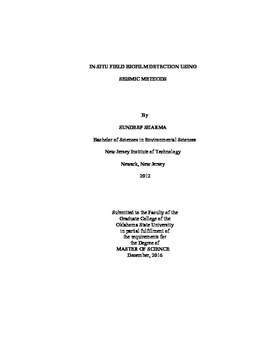| dc.contributor.advisor | Atekwana, Estella | |
| dc.contributor.advisor | Priyank, Jaiswal | |
| dc.contributor.author | Sharma, Sundeep | |
| dc.date.accessioned | 2018-06-29T14:41:10Z | |
| dc.date.available | 2018-06-29T14:41:10Z | |
| dc.date.issued | 2016-12-01 | |
| dc.identifier.uri | https://hdl.handle.net/11244/300375 | |
| dc.description.abstract | Biofilms are ubiquitous in subsurface environments and are being used in a variety of engineering and remediation applications. Their ephemeral nature makes them hard to detect and, as a result, the much needed in-situ imaging of their growth and distribution in time and space has remained a challenge. Laboratory studies have suggested that seismic waves, both Pressure (P) and Shear (S) modes of propagation, are sensitive to biofilm distribution but such observations have not been put to use in field settings till date. In this proof-of-concept study, use of surface seismic methods in detecting biofilms in-situ in field settings is demonstrated using a landfill site in Norman, Oklahoma, as an example. The experiment is to invert transmission and ground-roll waveform acquired along a 130 m long profile. Results show 50-60% increase in S-wave velocity and ~80% increase in P-wave attenuation within the water table oscillation zone. Environmental scanning electron microscope along with X-ray Diffraction images of soil samples from various depths affirms that presence of biofilms and not mineralogy sets the water table oscillation zone apart from the background. This finding is also consistent with sonic experiments in laboratories simulating biofilm growth in transitional environments. This paper further shows that a simple mechanistic model of biofilms coating quartz grains explains the anomalous increase in S-wave velocity due to presence of biofilms. Our results may be applicable to remotely detecting biofilms in biogeochemical hot zones (such as hyporehic zone, contaminant plume fringe and groundwater fluctuation zone), soil remediation, biobarriers, microbial enhanced oil recovery, and carbon sequestration studies. | |
| dc.format | application/pdf | |
| dc.language | en_US | |
| dc.rights | Copyright is held by the author who has granted the Oklahoma State University Library the non-exclusive right to share this material in its institutional repository. Contact Digital Library Services at lib-dls@okstate.edu or 405-744-9161 for the permission policy on the use, reproduction or distribution of this material. | |
| dc.title | In-situ Field Biofilm Detection Using Seismic Methods | |
| dc.contributor.committeeMember | Vilcaez, Javier | |
| osu.filename | Sharma_okstate_0664M_14892.pdf | |
| osu.accesstype | Open Access | |
| dc.description.department | Geology | |
| dc.type.genre | Thesis | |
| dc.type.material | text | |
